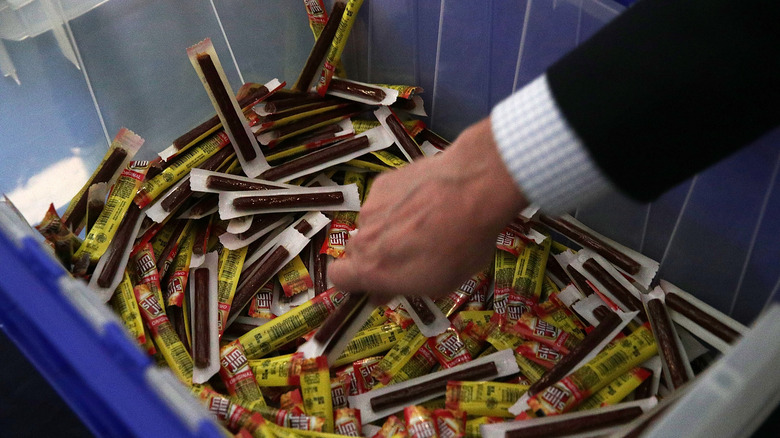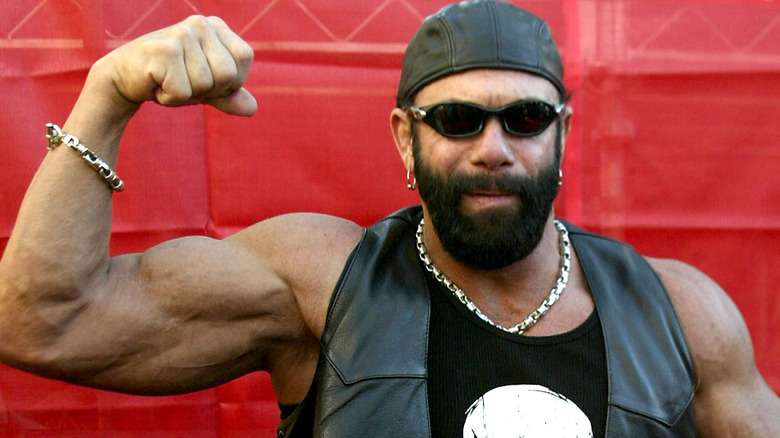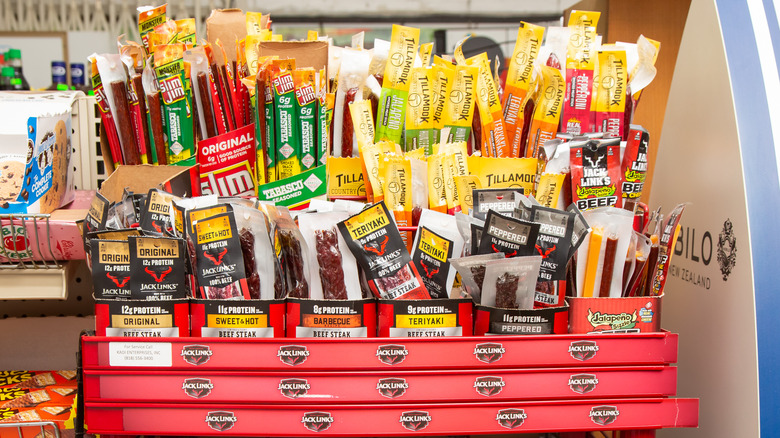Why Slim Jim Started Using Pro Wrestlers In Its Commercials
Pro wrestlers' eating habits can stun people — and that's exactly what Slim Jim relied on at the end of the 20th century to get teenage boys to eat its snack. How did such a need arise in the first place, though?
The story of Slim Jims is almost a hundred years old. In the 1920s, Slim Jims' creator, Adolph Levis, sold condiments, pickled meats, and spices to taverns, per Mel. About a decade later, Levis reiterated on his business idea, teaming up with a meat packer to make and sell dried beef sticks. Soon enough, they were dubbed "Slim Jims" in order to appeal to the formal barflies of the mid 1900s. For 20 years, according to Thrillist, Slim Jims enjoyed success in Northeastern U.S. bars., kept fresh in jars of vinegar. The mascot? A man wearing a tux and top hat (via the Dispatch, provided by Google).
Things took off in the 1950s and '60s. As Mel explains, the '50s saw Slim Jims wrapped in cellophane and sold in convenience stores. As more and more people started taking road trips, more Slim Jims were sold. Then, in '67, Levis sold his company to General Mills, and Slim Jims went nationwide. Things seem to have gone swimmingly in the '70s, as covered by the Dispatch, but the '80s saw Slim Jims having a bit of a midlife crisis.
Slim Jims did some soul searching
In the '0s and '90s, things began as business as usual, with Slim Jims going to GoodMark Foods, another meatpacking operation, per Mel. What sounds boring had an exciting impact, however. In the late '80s, the adult snack underwent market research, and it turned out teenage boys — not men and certainly not grown women — were the biggest fans of Slim Jims, per a 2001 AP report. So, the advertising strategy became all about juvenile, boyish irreverence and rebellion.
The well-liked "snap" of biting into a Slim Jim was also key, according to The Takeout. But who would be the face of this snappy angst (besides the "Slim Jim Guy")?
A few individuals were considered. The Takeout notes that a comedian was offered the role. But after being rejected, Slim Jims turned to the World Wrestling Federation, and the Ultimate Warrior was used instead. One commercial shows the Ultimate Warrior yelling at bored teenagers to "Snap into a Slim Jim," spicing up their hangout. But it's the seven-year tenure of "Macho Man" Randy Savage as spokesman that's best remembered by jerky-enjoyers. Whether he was picking up the tempo at a sleepy barn dance or lighting up a dimly-lit lamp store, Savage always brought energy to adolescent boys' humdrum lives. Yet, come 2000, Macho Man stepped away from the loud-mouthed role.
What does the future hold for Slim Jims?
The beef jerky snacks are now owned by Conagra Brands, which also owns food products including Duncan Hines, Healthy Choice, and Marie Callender's. Yet, according to Thrillist, Slim Jims now face competition from jerky sticks that are seen as fresher and fancier.
Mel notes that Slim Jims tried to become "healthier" in the 2010s, with offerings that highlighted protein and included "grass-fed beef." Yet, its advertisements still use wild ideas, such as sending a Slim Jim to space or introducing a tatted-up Fairy Snapmother as mascot. The company even hired a superfan Instagrammer, who posted low-effort memes about Slim Jims, to help it market its product, per Better Marketing.
Macho Man Randy Savage died in 2011, notes Mel. He may be gone, but he's certainly not forgotten by wrestling fans and beef-jerky boys alike. As reported by Fox 59, Macho Man action figures were unveiled in 2019 to commemorate his iconic Slim Jim commercials. While this may seem like a distasteful cash grab to some, Savage's brother, Lanny Poffo, assured Sports Illustrated, "Randy loved Slim Jim and Slim Jim loved him. He believed in the product and saw this as another way to be accessible to his fans." Pro wrestling came and went from Slim Jims' ads, but its beefy moves had a lasting effect.


